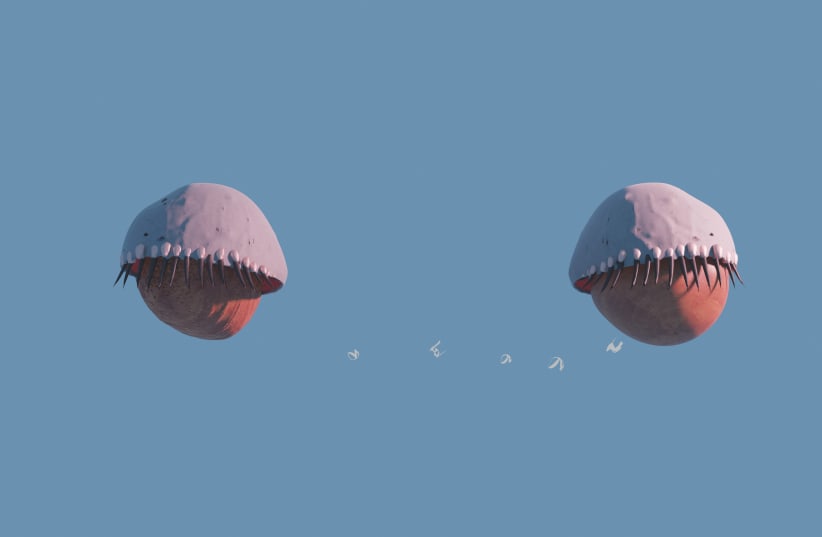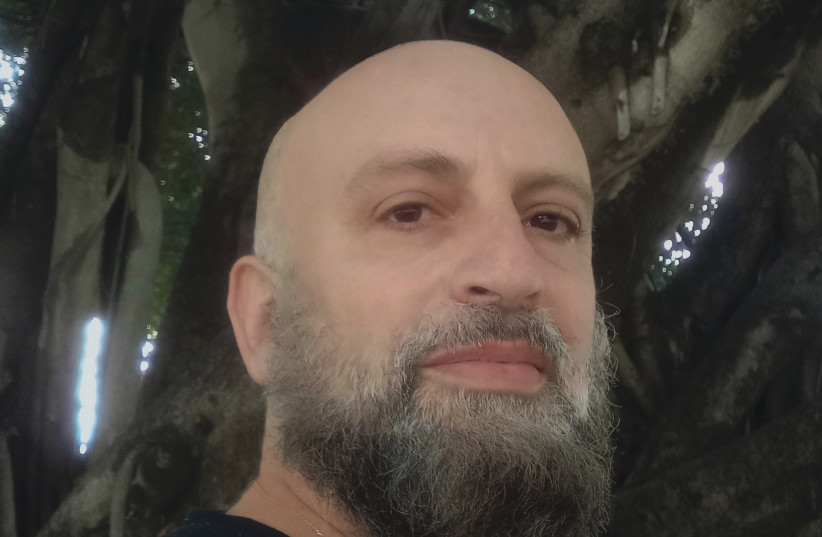In darkness, the sculptures of Eitan Ben Moshe fill the halls of the Bat Yam Museum of Art while six bewitching art videos he made for his latest exhibition World Chants flicker, their sound filling the space. The first floor is devoted to his art video called Mother. The music of the shamisen lends this homage to late Butoh dancer Kazuo Ohno’s same-titled 1998 work a bouncing rhythm.
The second floor is devoted to five more of his art videos: Rejoice, Rejoice; Little Sailboat; From Aomori; The Nightingale; and While You Live, Shine! These five are in dialog with famous songs or poems. They include Israeli works such as “I Believe” by Shaul Tchernichovsky and “The Sailboat Flows” by Natan Yonatan. Some works were written outside Israel, like a Japanese folk song about the changing seasons and a Persian song written by Taqi Bahar during a time of upheavals in Iran.
The last of this group of five is linked to the oldest known musical composition, the Seikilos epitaph from the first century. Accidentally found engraved on a pillar, the epitaph serves as a fantastic introduction to Ben Moshe’s oeuvre. He loves to hide his works, to camouflage them.
Curator Ruti Direktor once described an early exhibition by him, at a bank located on Tel Aviv’s Herzl Street, as “ugly,” noting that there is a tremendously liberating quality in the decision to make such unusual works. Located beneath a bridge at Heil Hashirion interchange, The Pearl was picked by a homeless person as a temporary living space.
“He now has a contemporary artwork in his living room,” Ben Moshe told Leah Abir for Tohu. He said that he embraces the concept that everybody has a spiritual nature, from the person making falafel to Mark Rothko. When he was exploring Butoh, he used to break into unused building sites and dance.
Created in Japan after the Second World War, Butoh seeks to break away from formal Japanese dance tradition, dancer Ayelet Ulman told The Jerusalem Post. She noted that Westerners might hear shamisen music or see white-painted faces and mistake this for a traditional Japanese form, but the truth is different. The goal is to attain a movement that offers the full range of our emotions, the dark as well as the light. By dancing at construction sites, Ben Moshe was being faithful to the actual space he and other people spend their days in.
“I discuss foreign cultures using clichés that are comfortable for representing my interests,” Ben Moshe told the Post. “After all, there is no such thing as the Butoh,” meaning a definitive form of this dance.
He admitted that “mindfulness had become a gimmick used by every hi-tech firm that continues to ruin the world. But for me, this is vitally important because the present is never the same: it truly is living.”
“The world had been weaned off many illusions,” he said, “like the faith in the holy trinity of progress/ democracy/ technology. Faced with dogmas such as these, the post-modern thinkers were a great dismantling force, but my proposal is different: that it is possible to point a person on a path towards wisdom that is not a mere repetition of a spectacle culture sound-bite.”
A political statement
Three years in the making, World Chants is marked by a black flag at the museum’s entrance. A patient eye will note the eye on it, the same seeing orb we see in Little Sailboat.
“Our country faces real existential threats,” Ben Moshe told the Post, noting that he would not take to the streets at such a moment. “But I am a citizen in a country that has racism in it: also inside the current government.”
Hidden in darkness, an enormous glass fist lurks next to a magazine ad promising “A Film for Every Taste.” Ben Moshe’s refusal to accept a consumerist status quo can be felt.
The works require adjusting one’s eyes to the darkness. The videos are much more enticing, but careful study of the physical art pieces on display will reveal a slow dance of life. Hardened plant-like beings explore one another – and even large stone-like seeds are changed by the passage of time, which imprints them with gashes.
The lyrics of the songs used – “Break this cage and overrun it” for example, taken from the Iranian song, or “while you live, shine/ don’t let sorry you benight [make you dark],” taken from the ancient Greek poem – are digitally sculpted and changed. This artistic decision is grounded in Ben Moshe’s childhood, when he visited Miriam Yalan-Shteklis, a family relative.
Despite her not being a native Hebrew speaker or a mother, Yalan-Shteklis wrote some of the best-loved songs for children in Hebrew literature. “She sculpted existing words into a form that would fit her poems,” he explained: “She sculpted in language.”
For this reason, the art videos do not offer themselves easily. Their visual magnificence – a pair of eyes opening to a flowing world in Little Sailboat or an eggplant-like organism in relation with other, tiny creatures in Rejoice, Rejoice – need patience to fully appreciate. Those who have it, will be richly rewarded.
World Chants, curated by Hila Cohen-Schneiderman, will be shown until Friday, July 5 at the Bat Yam Museum of Art, 6 Struma Street.













